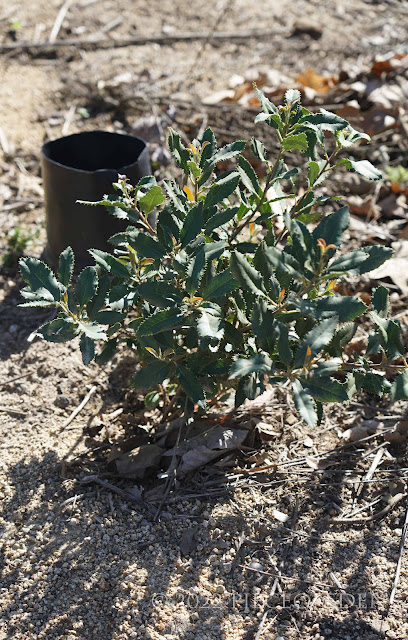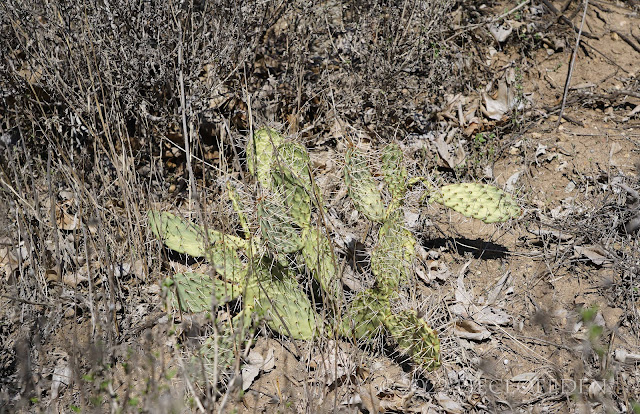Above, Baccharis pilularis ("Coyote Bush") in bloom
Along with a few members of our local garden club, I attended a special tour given at a county wilderness park. The volunteer tour guide, with permission from the county, has been working to restore the park with location-appropriate native plants. He has been planting native plants, and watering them though their first summer with very little help since 2009. He's grown some of the plants himself and bought others as he could afford them, or as donations trickled in.
Ted, Local Hero:
After almost ten years of effort, in 2017, the area he had labored to restore burned to the ground.
There were few survivors of his nine years of effort. Would you have given up? He didn't.
An Encelia about to get a home. The red flag identifies and helps to locate plants to be watered through their first summer. After that, a majority can survive on their own:
 Heteromeles arbutifolia ("Toyon"), recently planted:
Heteromeles arbutifolia ("Toyon"), recently planted:
Rhus integrifolia, ("Lemonade Berry")
...or is that an Oak?
Food for tiny butterflies, native bees, and moths is provided by Heterotheca grandiflora "Telegraph Weed":
A native Aster (species unknown) with tiny white flowers is summer deciduous:
I think this might be Baccharis salicifolia ("Mule Fat"):
The name "Mule Fat" is attributed to Forty-Niners (California gold miners) who would tie their mules to these shrubs so mules could graze on them.Our guide explained that "Mule Fat" forms a monoculture, crowding out every other species and quickly forming layers of dead material many feet thick that stoke ferociously hot chaparral fires, as happened in 2017. Even native plants can be thugs.
Here's a tiny example of thatch buildup:
Malosma laurina is perfectly adapted to chaparral fires. Below ground it forms a woody tuber (lignotuber) and if there's a fire that burns everything above ground, Malosma can rapidly re-sprout from that lignotuber.
Growing by the side of the road in the neighborhood. It grows all over around here, without irrigation.
Reddish stems, like Arctostaphylos, though less picturesque.
When growing in mostly shade, the leaves do not exhibit their typical "taco fold" shape. In full sun, the sides of each lea curl inward to reduce sun exposure and heat stress.
Malosma is incredibly tough, except for one thing: it is not frost-hardy. Early farmers in Southern California would look for Malosma because it indicated frost-free areas, good for citrus and avocado groves.
Populus fremontii, ("Fremont's Cottonwood") turning gold in autumn.
Sambucus mexicana "Western Elderberry", waiting for rain:
Quercus agrifolia ("Coast Live Oak"), struggling in the current drought. Ted described a vision of a few decades from now, when the oaks he has planted have grown into a forest in which to stroll, with the shrubs like Toyon and Malosma as understory, all alive with thriving native creatures. What a beautiful park this can become. Prunus filicifolia ("Hollyleaf Cherry")
Isocoma menziesii ("Menzie's Goldenbush"):Eriogonum fasciculatum "California Buckwheat" in foreground, the Isocoma middle distance, Lemonade Berry/Toyon, far distance: Asclepias augustifolia "Narrow Leaf Milkweed":
? Artemesia?
Encelia farinosa ("Brittlebush") on the right, Eriogonum fasciculatum "California Buckwheat" on the left: Opuntia littoralis "Coast Prickly Pear", fairly dessicated at this time of year:
Ribes species (?), not sure which: malvadceum(?) or R. speciosum(?) "Chaparral Currant"(?):

Be careful of attractive autumn foliage color: Toxicodendron diversilobum ("Pacific Poison Oak"):
Encelia "Brittlebush" flowers:
Salvia mellifera ("Black Sage"):
Salvia apiana ("White Sage")
Salvia apiana is currently under siege. A valuable source of food for native butterflies, bees, and hummingbirds, there's a current viral fad to burn the stems and leaves for "purification". Grow your own if you need "purifying", please, so our native land is not purified of Salvia apiana and all the small creatures that depend upon it for food.
As we walked with our guide, I realized he was talking about the park just as any gardener would. Statements like:
--"The soil here is awful, but right over there, I can grow anything."
--"A long time ago someone planted bermuda grass there, and I can't get rid of it."
--"Watering. When it's hot. Oh, boy."
--"Those keep dying on me."
--"I planted that six years ago, and look at it now!"
--"Somebody keeps stepping on that. I put up those wires to keep feet out. They're working."
-- And, of course, "Those #$%@!*+ rabbits!"
The man is gardening nature, with nature, for nature. How cool is that?
If you are local and want to help, the next Restoration Day at Peter's Canyon is Sunday, Dec. 4th. Check status in case of rain. Information here. Prepare to water...or not. Rain showers are predicted for late this week!
It's his home, too:






























What a great man. I'm so glad he didn't give up!
ReplyDelete👍😊
DeleteThank you, Ted! I find lignotubers are so resiliently sexy! Thank you, Hoov, for this love letter to our dry, dusty, fragile SoCal landscape! I fervently hope Ted sees his vision of a forest of Coast Live Oak come to pass.
ReplyDelete👍😊
DeleteOh wow, what a story. What a hero, and good to know that folks are helping to re-establish it. My second thought, after the shock, was...will some of the perennial plants grow back? It sounds like some of them did, and then some of them, and trees and shrubs, had to be replanted? Sorry to hear about the fire, but glad to know folks are chipping in to help.
ReplyDeleteChaparral fires are "normal"--native plants have evolved to re-sprout from seed or from their bases, like the Malosma. Many had to be replanted. Controlling the number of the "Mule Fat" plants and limiting their thatch (which is extremely flammable) is going to reduce potential damage in the future.
DeleteTed is a remarkable person, a true force of nature. He has a mission and he's not letting anyone or anything get in the way of it. I've never seen Baccharis pilularis that looked that good. Does the county provide any support? A source of water, someone to clear paths as needed?
ReplyDeleteThe paths are maintained, and there is a water source available at the north end of the park, which is where all the restoration work is taking place. The south end, the middle, no water available--plants must depend on a couple of years of generous rainfall and luck to get going.
DeleteTed is a hero, just like you said. I'm so grateful there are people like him, making the world around us better.
ReplyDelete👍😊
DeleteTed's legacy will live on for a very long time. With climate changes we need all the native advocates. Fire is just part of the natural cycle but it must have devastating to see all his hardwork (and the time spent) disappear in one fell swoop. Thanks for this good news story. Need more of these currently.
ReplyDeleteYes indeed! There are good things going on, not just the other stuff.
DeleteInteresting to see some of your local native plants Hoover Boo. Ted is what we in Australia refer to as a total legend. What a guy 🙂
ReplyDelete"Total legend" 👍😊
DeleteThat was me. Gah.
ReplyDeleteno problem! Happens to me too with blogger's weird "comment as" behavior the past few months!
DeleteLocal hero, indeed. What an uplifting story! And what a wonderful and admirable mission to have. The fact that the fire didn't break his spirit indicates that he's as resilient as the landscape he nurtures. All power to him!
ReplyDeleteA reminder that there are many many good people in the world that we never hear about. The news often only covers the jerks.
DeleteHard to see when freshly burned. But so exciting to see both what returns and what emerges 'only after fire'. Annuals, orchids, bulbs encouraged by kind rain.
ReplyDeleteIt was amazing how fast the area recovered. Like some SA fynbos plants, the Malosma has a lignotuber and sprouts new growth from it almost immediately after a fire.
Delete